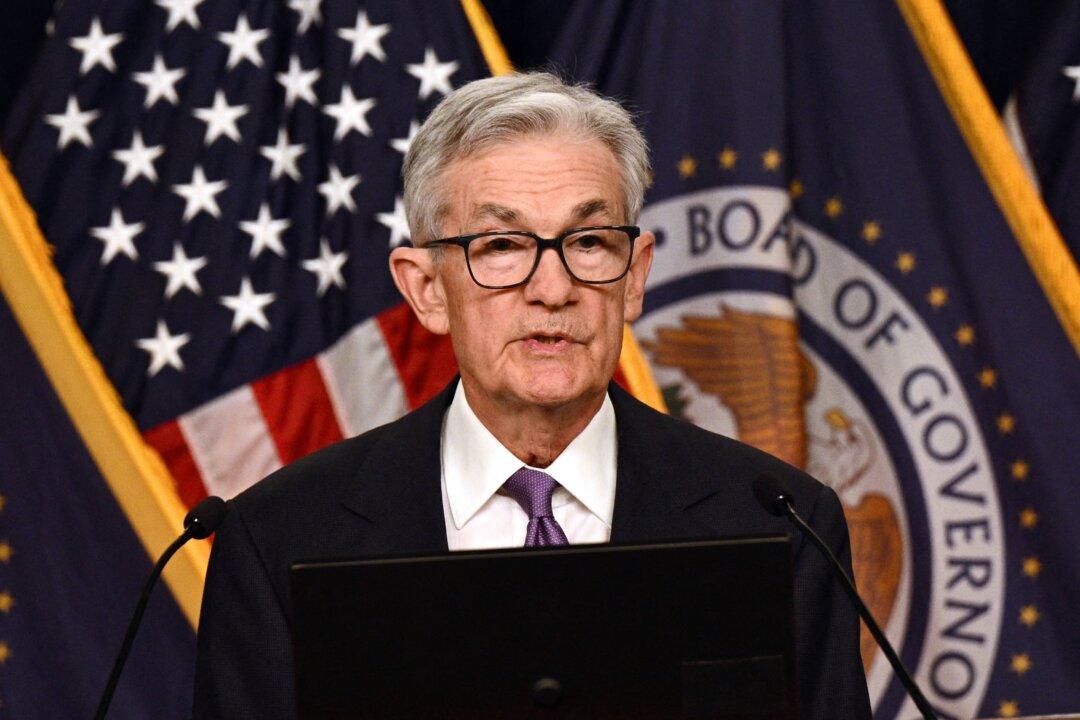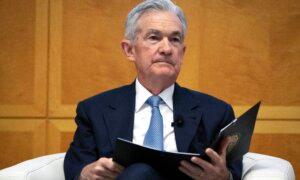The Federal Reserve’s policy-setting committee on Dec. 13 left interest rates unchanged at a target range of 5.25 percent to 5.50 percent at its final policy meeting of the year.
It was the third consecutive meeting that the Federal Open Market Committee chose not to raise rates.
Recent data suggest that economic growth has slowed from the strong third quarter, FOMC members stated. While the labor market has moderated since the beginning of the year, employment gains remain strong as the unemployment rate has remained low. Inflation has also eased over the past year but remains elevated, the Fed said.
“The U.S. banking system is sound and resilient. Tighter financial and credit conditions for households and businesses are likely to weigh on economic activity, hiring, and inflation,” the FOMC statement said. “The extent of these effects remains uncertain. The Committee remains highly attentive to inflation risks.”
Future policy decisions will be data-dependent, and officials will comb through the figures to determine if additional policy tightening is appropriate.
“The Committee will continue to assess additional information and its implications for monetary policy,” the FOMC statement said. “In determining the extent of any additional policy firming that may be appropriate to return inflation to 2 percent over time, the Committee will take into account the cumulative tightening of monetary policy, the lags with which monetary policy affects economic activity and inflation, and economic and financial developments.”
Policymakers will continue to trim the central bank’s holdings of Treasury bonds and mortgage-backed securities. The balance sheet currently sits at about $8 trillion.
The vote for a rate pause was unanimous.
At the December FOMC meeting, the Summary of Economic Projections (SEP) was updated. Officials expect the median policy rate to be 5.4 percent this year, then slide to 4.6 percent in 2024 and 3.6 percent in 2025. Additionally, the Fed’s dot-plot suggests that eight of the 19 officials are forecasting the policy rate to be above the 2024 median, and five are expecting it to be below.
Ultimately, the Fed is penciling in three rate cuts next year.
The U.S. economy is forecast to grow by 2.6 percent this year and by 1.4 percent in 2024. Inflation projections were lowered, with the Fed’s preferred inflation gauge, the personal consumption expenditure (PCE) price index, expected to be 2.8 percent this year, 2.4 percent in 2024, and 2.21 percent in 2025.
Fed Chair: ‘Very Good News’
Speaking to reporters after the FOMC meeting, Fed Chair Jerome Powell conceded that the institution’s tightening efforts have started to take hold, be it balancing the labor market or cooling inflation.However, even with the “very good news,” Mr. Powell told reporters that there is still a way to go.
“Inflation has eased from its highs, and this has come without a significant increase in unemployment. That’s very good news,” he said. “But inflation is still too high. Ongoing progress in bringing it down is not assured, and the path forward is uncertain.”
He added that higher borrowing costs have “flattened out” the housing sector and slowed business investment. This is leading to a slowdown in economic activity, although the GDP is poised to grow around 2.5 percent for the year as a whole, Mr. Powell noted.
When asked what the Fed is looking at to determine when to cut rates and by how much, Mr. Powell insisted that officials are assessing the totality of data, from inflation to GDP to the labor market.
“We are prepared to tighten policy further if appropriate,” he stated. “While participants do not view it as likely to be appropriate to raise interest rates further, neither do they want to take the possibility off the table.”
Additionally, Mr. Powell made the case that above-trend growth could support the need for a rate increase because it would make it harder to reach the 2 percent target objective.
“It makes it more difficult for us to achieve our goals. And if you have growth, it’s robust,” the Fed chief said. “It will keep the labor market very strong and probably will place some upward pressure on inflation. That could mean that it takes longer to get to 2 percent and keep rates higher for longer.”
That said, according to Mr. Powell, the economy could face recession risks next year.
Market Reaction
The U.S. stock market reacted positively to the news, as the benchmark S&P 500, the Dow Jones Industrial Average, and the tech-heavy Nasdaq Composite all rose about 1.3 percent. The Dow Jones Industrial Average closed above 37,000 for the first time.Treasury yields were red across the board. The 10-year yield tumbled 17 basis points to just above 4 percent, its lowest level since August. The 2-year yield shed about 18 basis points to about 4.55 percent, while the 30-year bond declined by more than 7 basis points to 4.23 percent.
The U.S. Dollar Index (DXY), a gauge of the greenback against a basket of currencies, fell by 0.5 percent to about 103.30.
Despite the jump in stocks, Giuseppe Sette, president of investment research firm Toggle AI, said the next few sessions should show if the FOMC decision will lead to a rally or a selloff.
“No news from the Fed on [Christmas]. In one of the most uneventful statements this year, the Fed keeps rates unchanged and remains ready to adjust policy to new information,” he said in a note. “The market rallied sharply in expectation of a dovish Fed, so the next days will show us whether this FOMC meeting will lead to a case of ’sell the news.'”
Markets seem to have abandoned the “higher-for-longer” narrative that had been uttered by Fed officials over the past few months, says Ali Hassan, the portfolio manager at Thornburg Investment Management.
What Fed Heads Were Saying
For weeks, the speculation on Wall Street has been that the Federal Reserve will start to cut interest rates in early 2024.“It would be premature to conclude with confidence that we have achieved a sufficiently restrictive stance, or to speculate on when policy might ease,” he said.
“Monetary policy will need to be nimble and respond appropriately to the evolving outlook and to the risks to achieving both parts of our dual mandate. I believe the current level of the funds rate positions us well to do that,” Ms. Mester, who is poised to retire in June 2024, said in a speech.
The policy rate is at, or near, its peak level, and it’s the most restrictive in 25 years, New York Fed President John Williams said. But everything will depend on the numbers.
The next two-day FOMC meeting will be held on Jan. 30 and 31, 2024.







